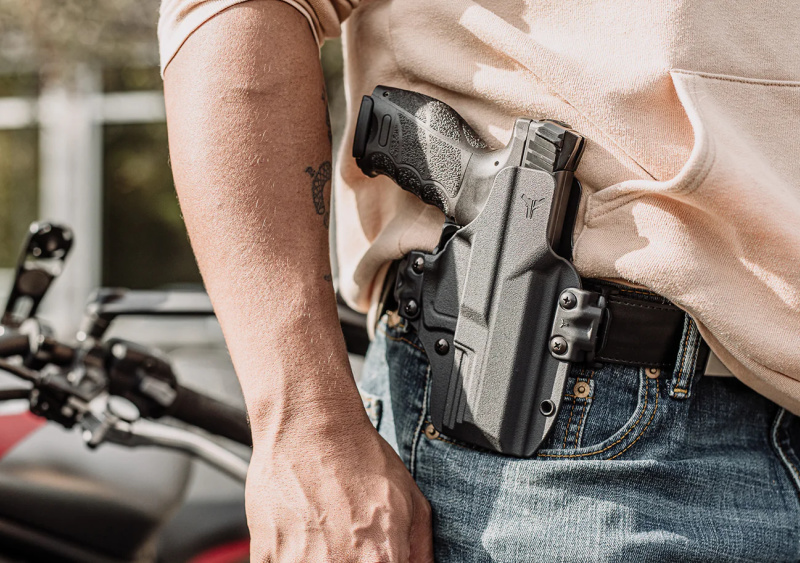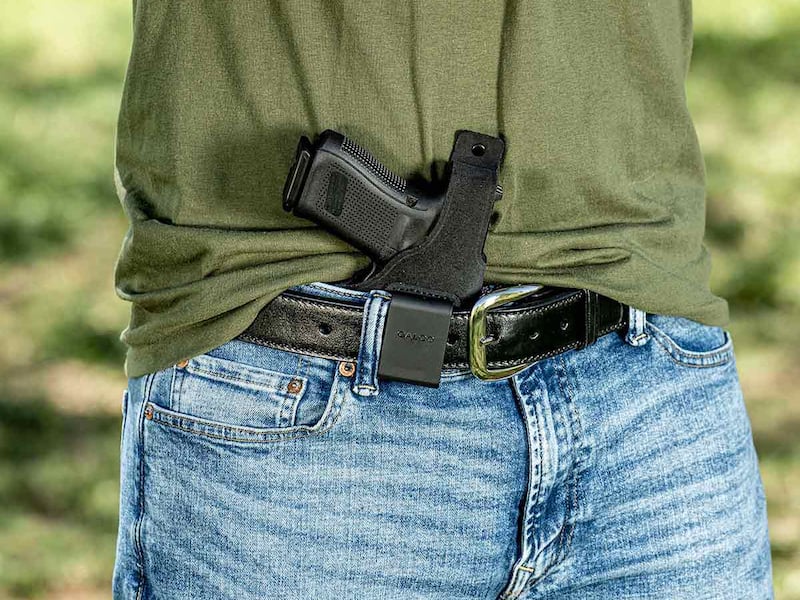Carrying a firearm requires a commitment and dedication to developing good habits. For the armed citizen, shooting on the range and completing additional training is part of upholding our responsibilities as good stewards of the Second Amendment and the right to self-defense. As I’ve previously discussed, skills are learned, not bought, through quality repetitions that enforce strong shooting fundamentals and sound thinking under stress.
If you’re like me, you’ve accumulated, or are accumulating, a firearms collection that seems to have no end in sight. There is always another firearm on the horizon that we want to purchase or are purchasing. My collection of firearms is diverse and nearly as broad as some’s wardrobe. Over the years, I’ve compiled a collection of firearms I’ve carried both in and out of uniform. Those firearms have been carried in every position from a pocket, shoulder, strong side, ankle, and appendix holster.

As a young law enforcement officer, I transitioned from carrying two spare magazines on my non-dominant side out of uniform to carrying three magazines at the front of my belt in uniform. While at the range, I quickly learned I’d engrained habits of accessing my magazines on my non-dominant side over years of carrying out of uniform. Ultimately, I spent a significant amount of time practicing both positions to develop sound habits for drawing spare magazines from both positions depending on the environment.
One of the greatest lessons taken from that experience was to always train with your carry setup. While many preach never changing your carry firearm, carry position, or daily “loadout”; this expectation is somewhat unrealistic. While I prefer to carry a full-size Glock 17, not all attire, environments, or conditions may be conducive to carrying the same firearm. Reality is far more complex than the simplicity of never changing your carry setup. Over the years, I’ve learned techniques and gained an understanding of how to carry different firearms in different positions while maintaining competency for those particular setups.
Building Consistency
A key element of carrying a firearm is to develop good habits. Part of developing good habits is practicing with your carry equipment. I routinely carry a pocket knife, flashlight, tourniquet, primary firearm, spare magazines, and a backup gun. These are all part of my daily personal defense loadout. These items are always kept in the same position when possible but occasionally I carry in a different position due to the activities or attire for that day.

Range trips with any carry equipment should be a required component of anyone’s firearms training regimen. The first time to draw and fire a carry firearm from a carry holster shouldn’t be in a gunfight. The same goes for every holster and firearm used as part of a daily carry package.
Slip-and-Capture
The Force Science Institute has been an excellent resource during my law enforcement career for understanding the complex dynamics revolving around the use of lethal force. Furthermore, they have conducted studies into a variety of issues surrounding lethal force encounters including the action-reaction gap, contact-and-approach of dangerous suspects, and other elements surrounding lethal force encounters.
Some years ago, the Force Science Institute introduced the concept of “slip-and-capture” to law enforcement. Over several years, there have been numerous controversial high-profile incidents of law enforcement officers mistakenly drawing their firearm and discharging it at a suspect when they intended to use their Taser. Force Science Institute attributed many of these incidents to slip-and-capture. Slip-and-capture normally occurs during high-stress incidents where an involved party executes an action that has been practiced more frequently when they intend to perform a less familiar and practiced action. For many years, law enforcement routinely practiced drawing and shooting firearms at the range with several hundred repetitions annually. Those repetitions grossly outweighed the number of repetitions conducted by law enforcement in practicing with their Taser. Policies and training have largely been changed to mitigate or prevent such instances. One of those is to practice drawing less lethal options from their belt more often and practicing transitions between those options.
In the realm of concealed carry, slip-and-capture is an applicable error that could occur to anyone if they don’t practice with their tools. As part of my nightly routine before going on duty, I practice an equal number of draws with a firearm, Taser, OC, and other items on my duty belt. Each repetition is designed to build competency and “muscle memory” as to what I’m drawing, why I’m drawing it, and what feedback I receive that confirms what I’m holding is the intended tool. Even if you carry in the same position with the same firearm daily, these drills build skills that translate to competency and confidence with your carry setup. Repetition strengthens and confirms – regardless of whether the habit being enforced is good or bad. Accordingly, repetitions in dry practice before daily carry should focus on quality over quantity.
Different Environments
In a previous career, I worked in an environment that required exceptionally discreet concealed carry. My attire didn’t allow for classic concealed carry behind my hip. Accordingly, I carried my backup on my ankle with a compact double-stack pistol in a belly band. This allowed me to discreetly carry with no belt clips or other obvious external signs I had a firearm. When not at work, I defaulted to strong side carry with an inside or outside-the-waistband holster.

The two aforementioned carry styles necessitated practice with those setups to ensure competency in the event they were used. This practice, both dry and live fire, was from seated, standing, and kneeling positions to access the firearm(s) under those environmental conditions. The practice of these skills exposed any issues with my equipment and carry configuration. One example was replacing the buttons on my button-down shirt with Velcro strips that allowed for faster access to my firearm. Had this practice not been conducted, the issues presented during dry and live fire would not have come to realization except in the direst of circumstances – when the firearm was needed immediately to address a life-threatening situation.
An additional consideration about carrying with different setups is to consciously practice indexing on your gear. In law enforcement, these movements are an indication a subject may be armed based upon their subconscious touching of where a weapon or contraband is located. In this example, the movements are conscious, non-threatening reminders of where your firearm is positioned and located. If I carry strong side, a simple bump of my elbow against the firearm on my waistband reminds me that my firearm is located there.

Ultimately, circumstances beyond our control may necessitate different carry setups. For some of us, it’s the joy of having enough firearms to rotate them like a clothing accessory. These rotations present issues that can be addressed through repetition and practice. The practice and repetitions must be done purposefully and properly. Good habits are built. They cannot be bought. A few minutes dedicated to quality practice on your carry setup of the day before stepping out the door is worth its weight in gold and can prevent potentially fatal errors.


